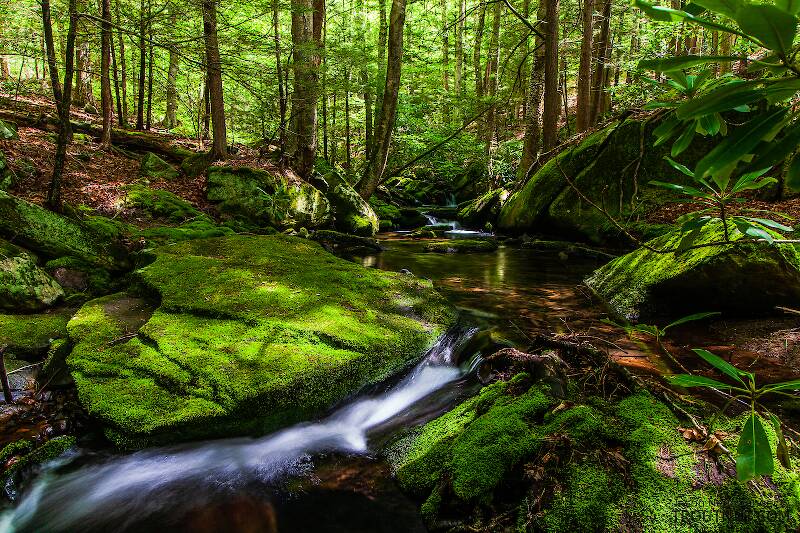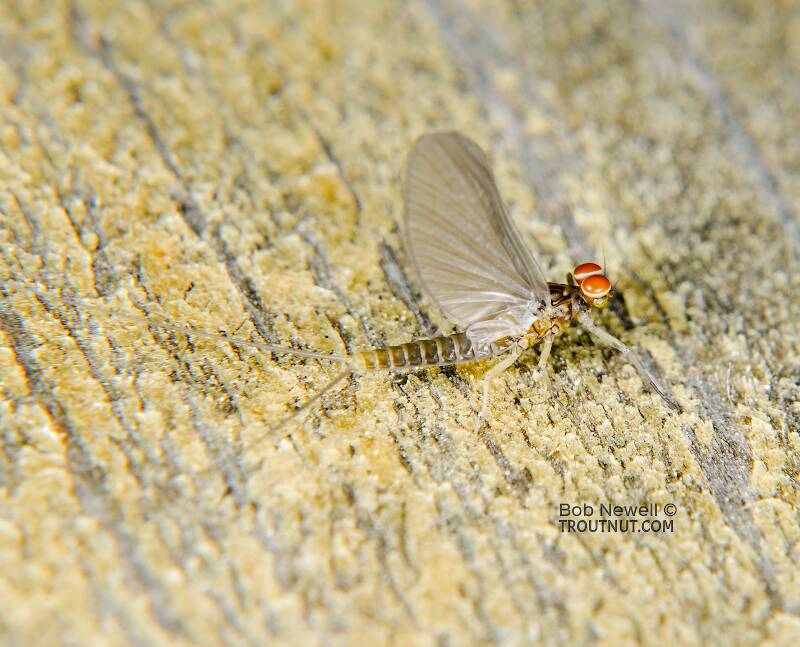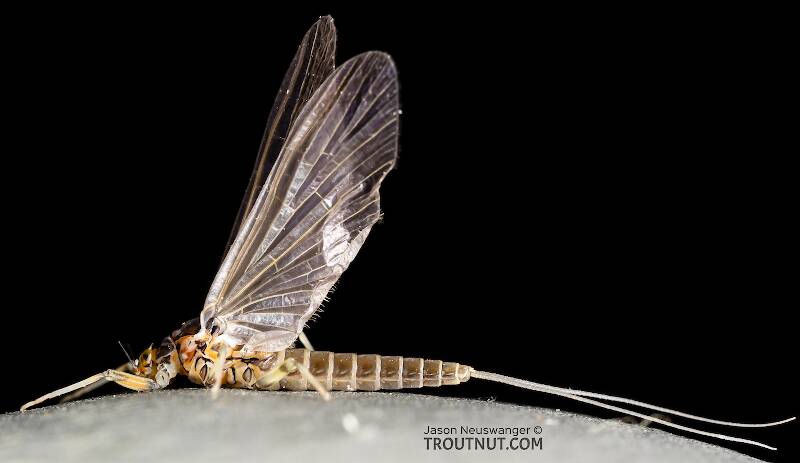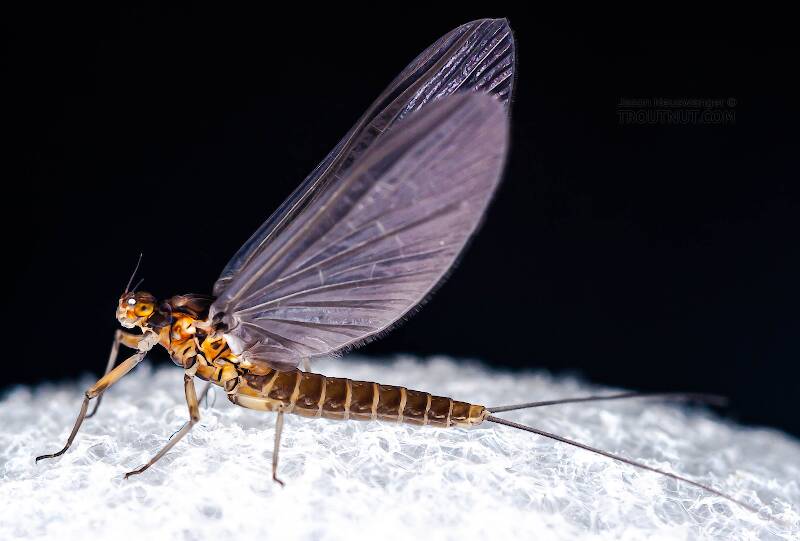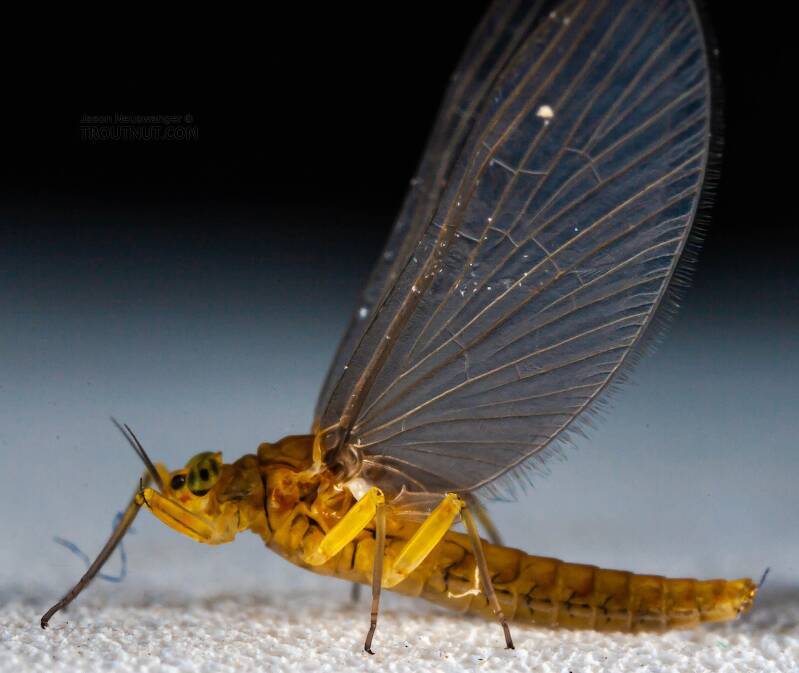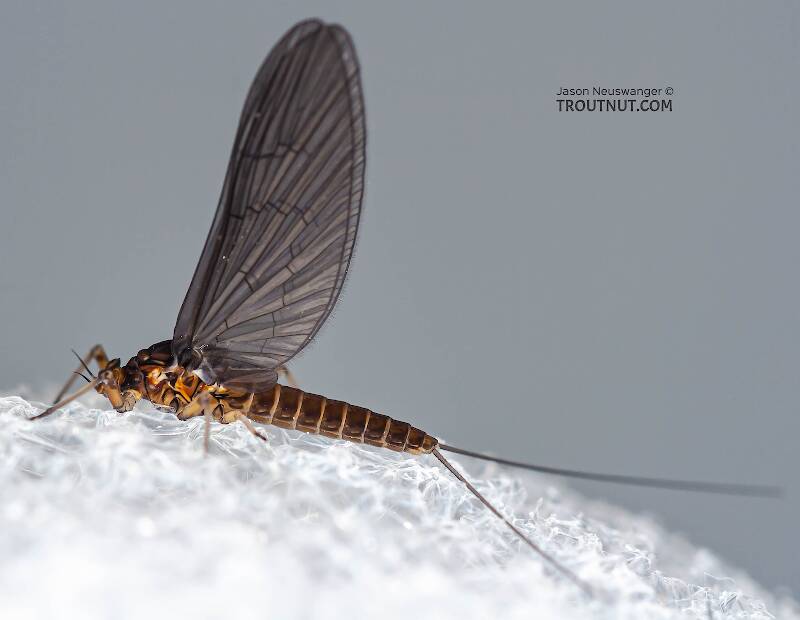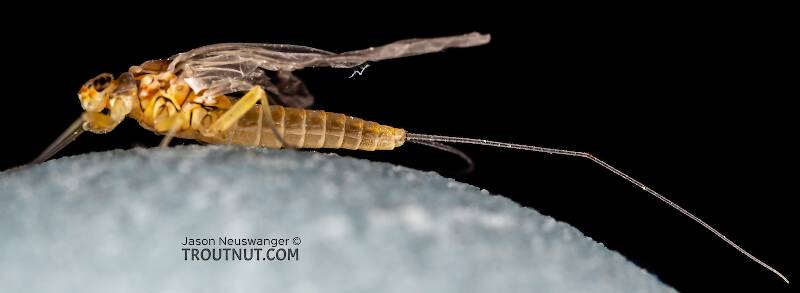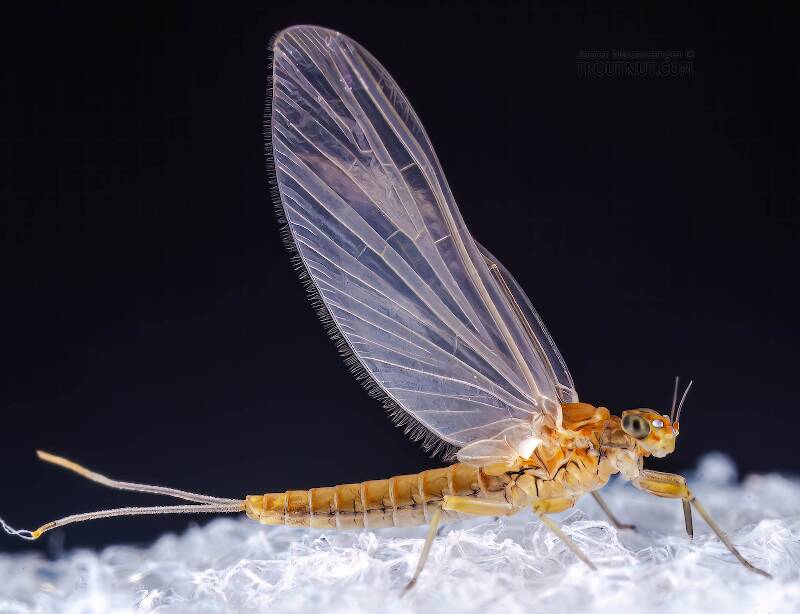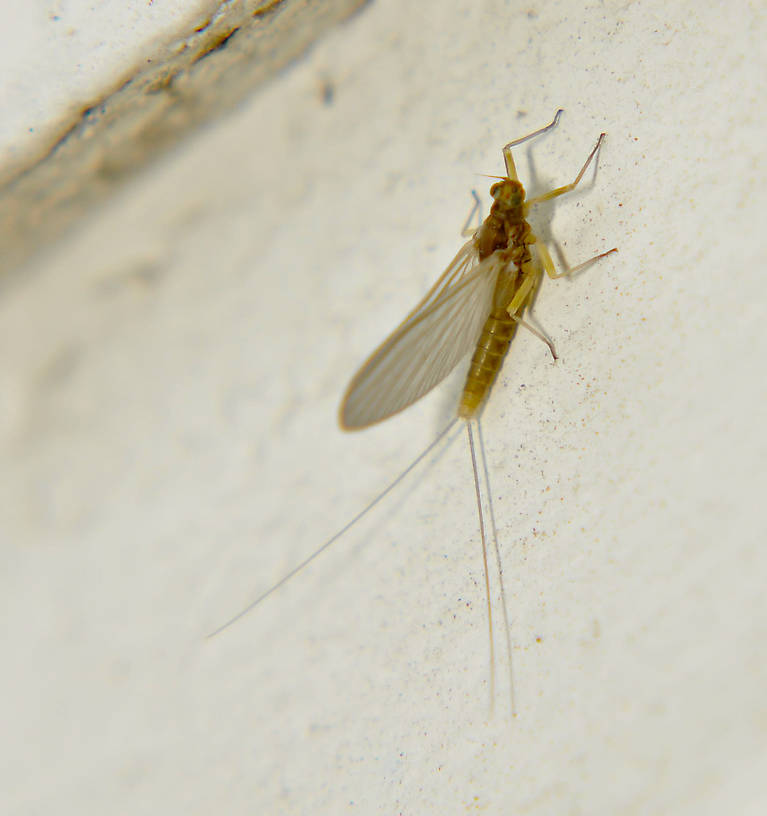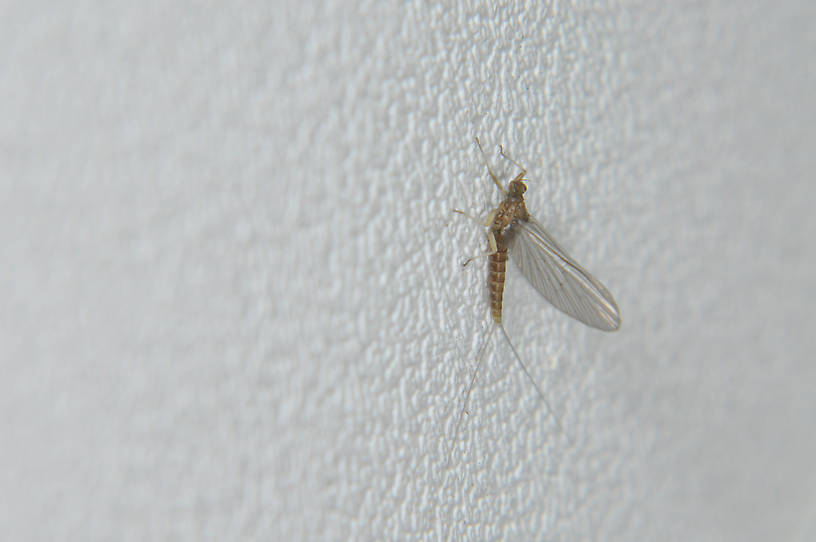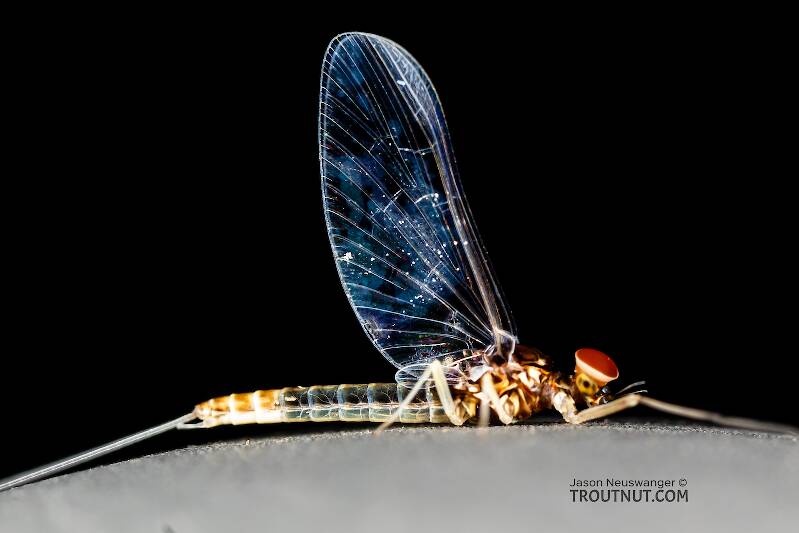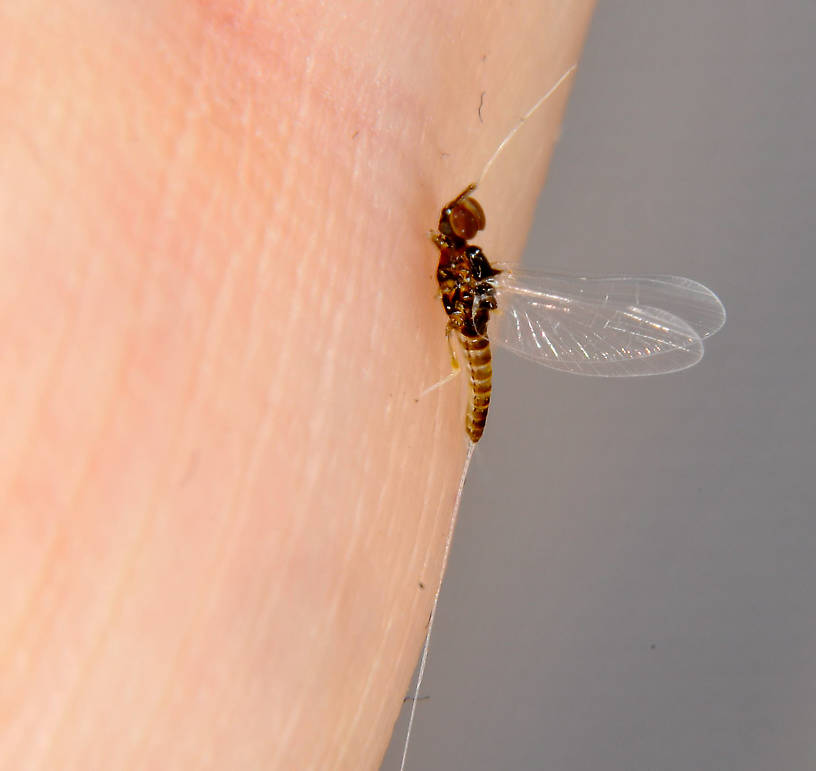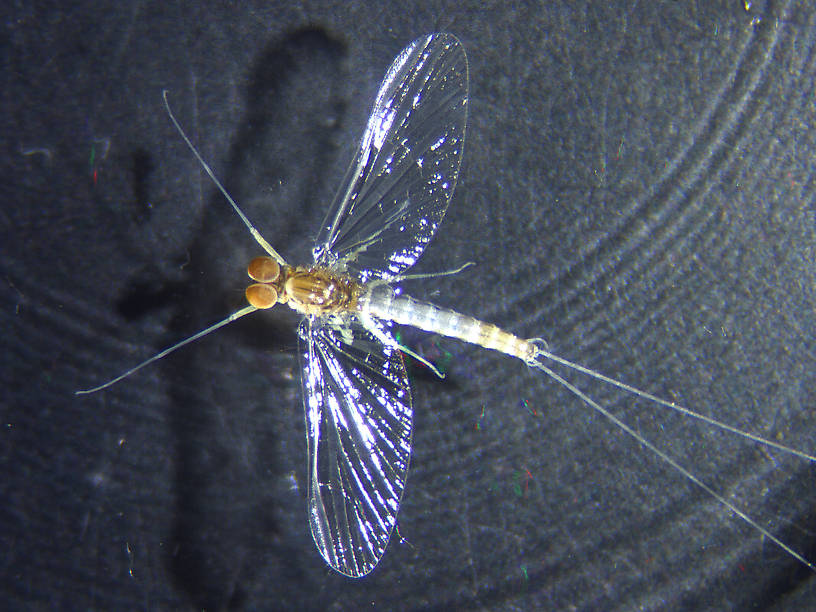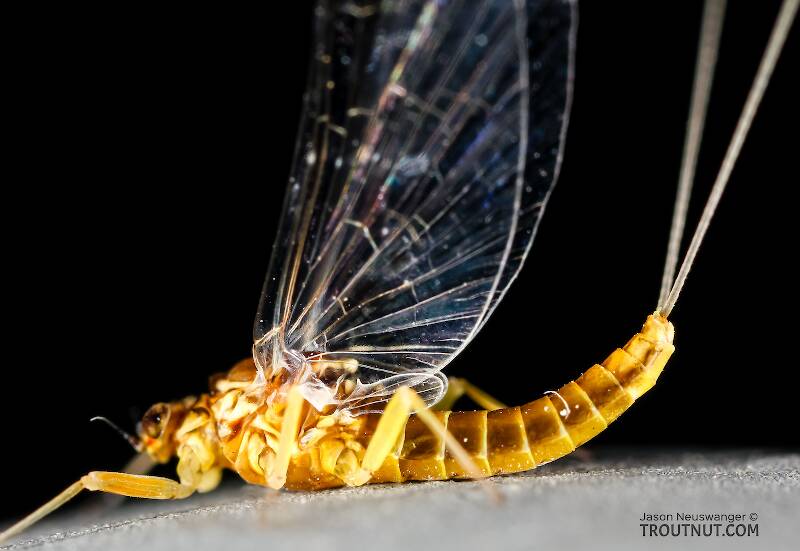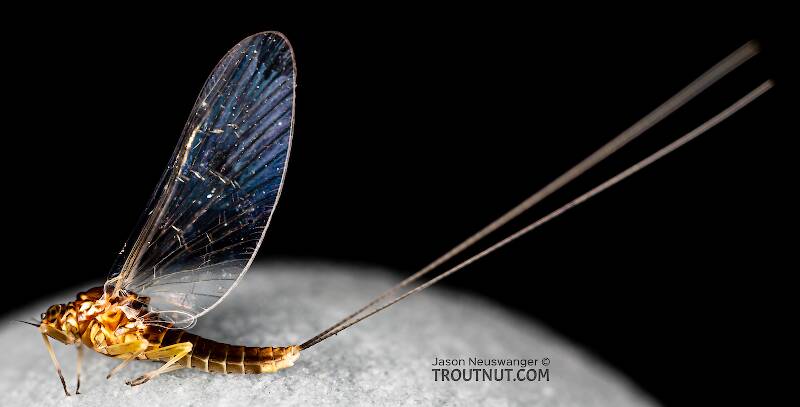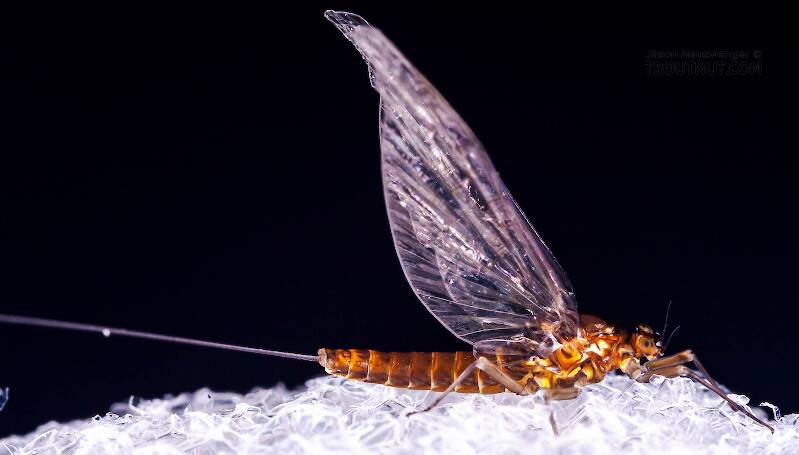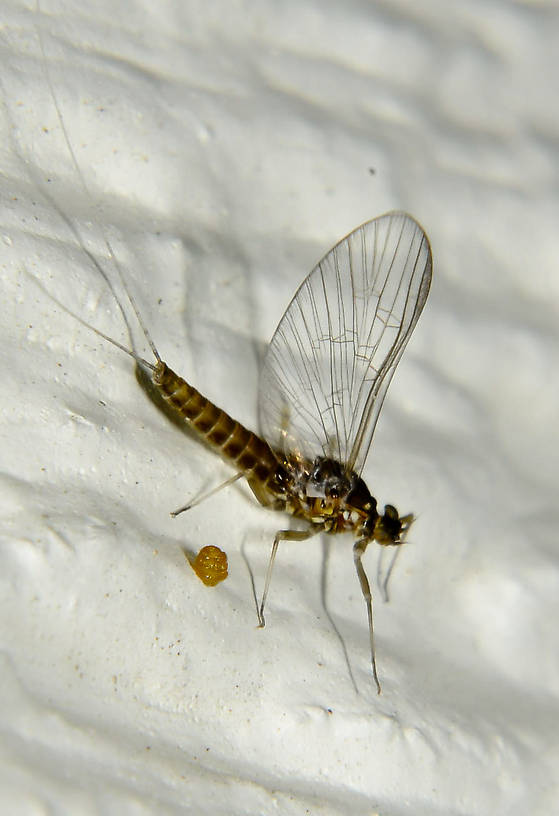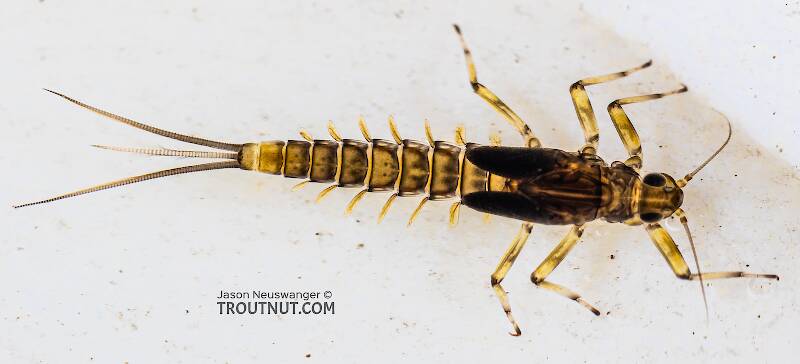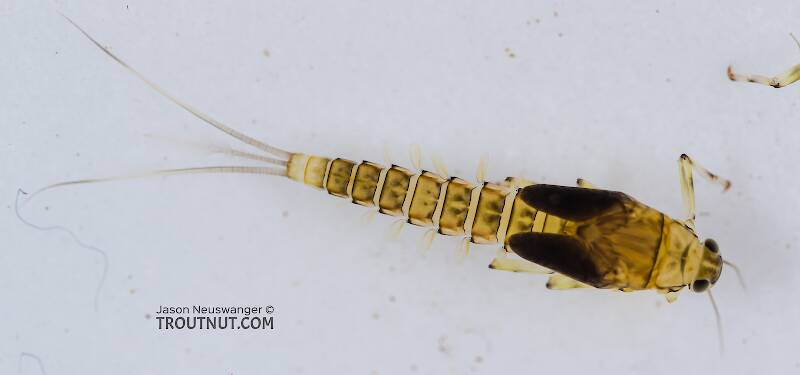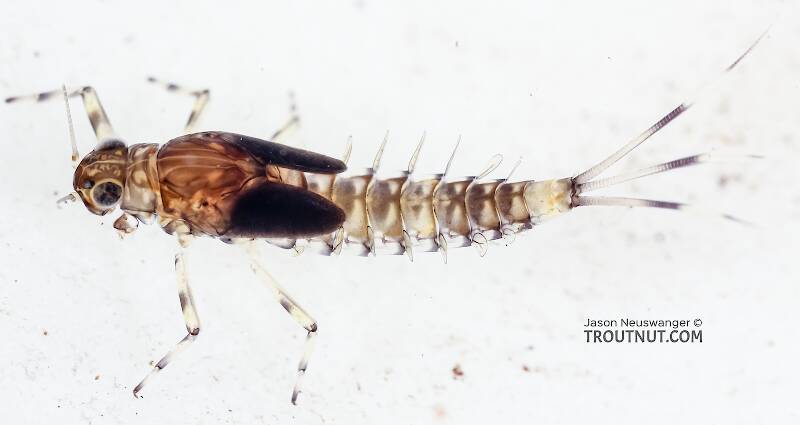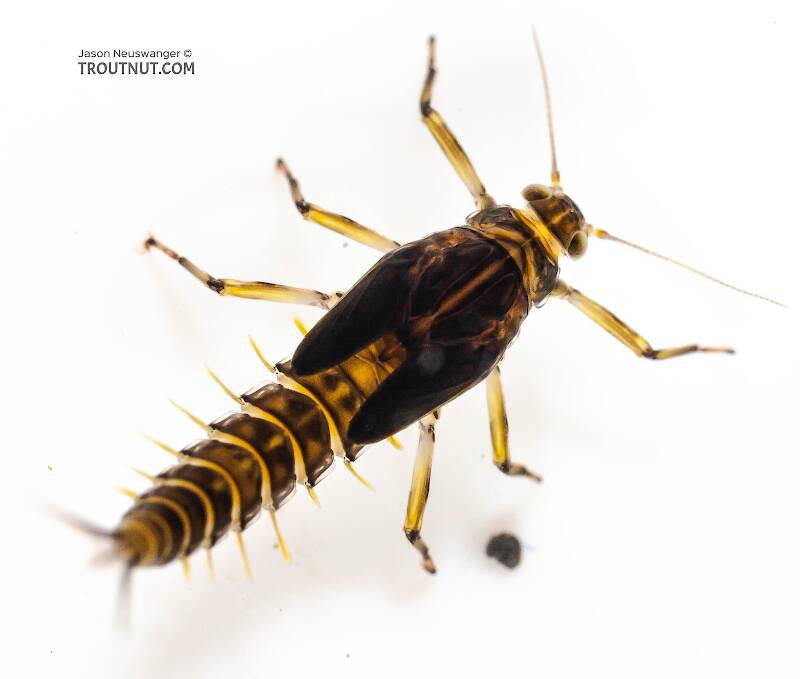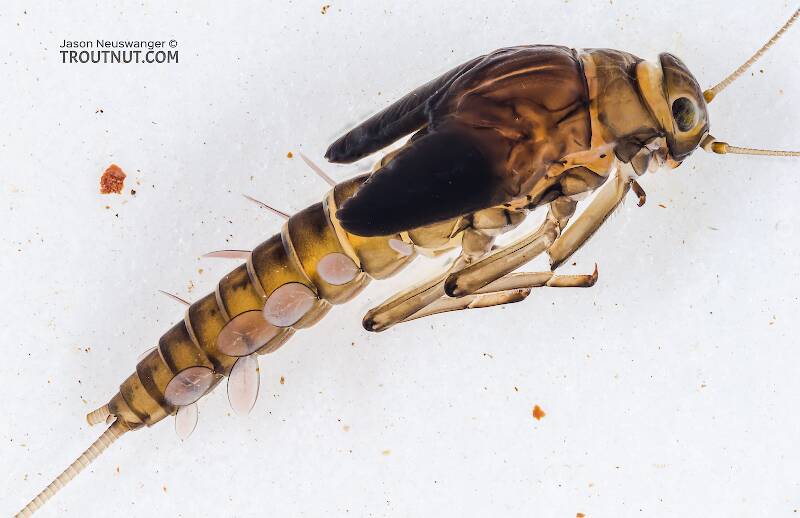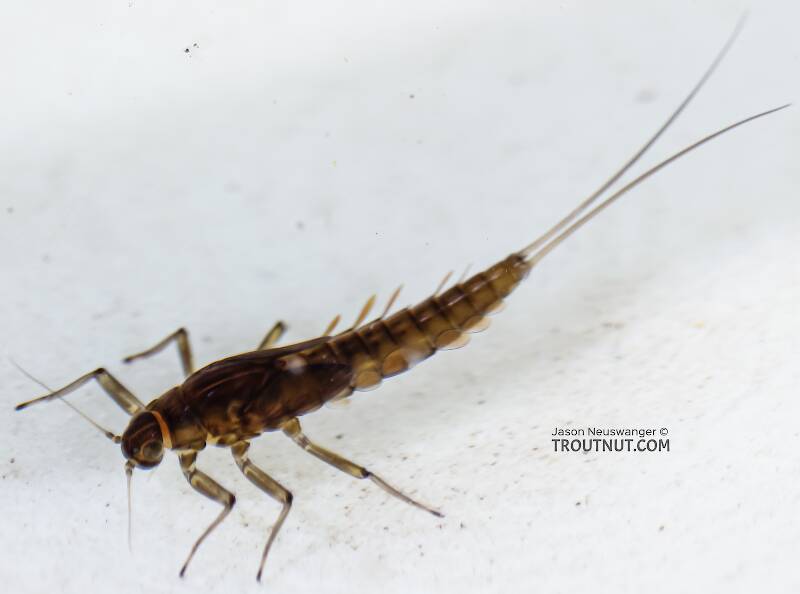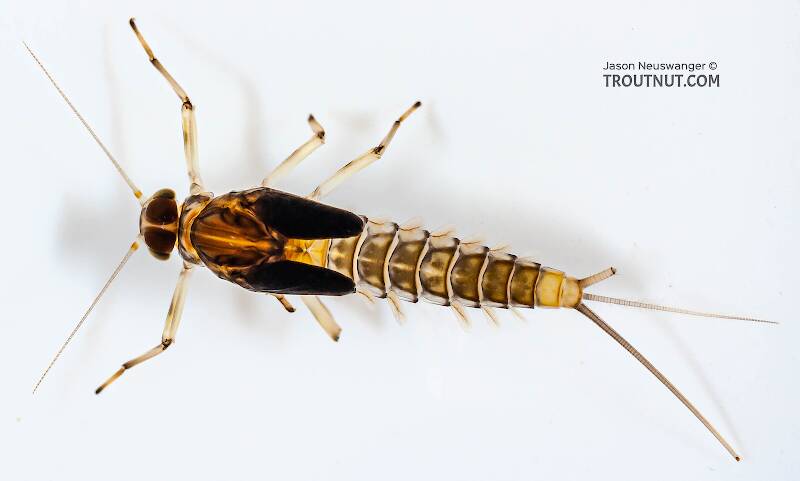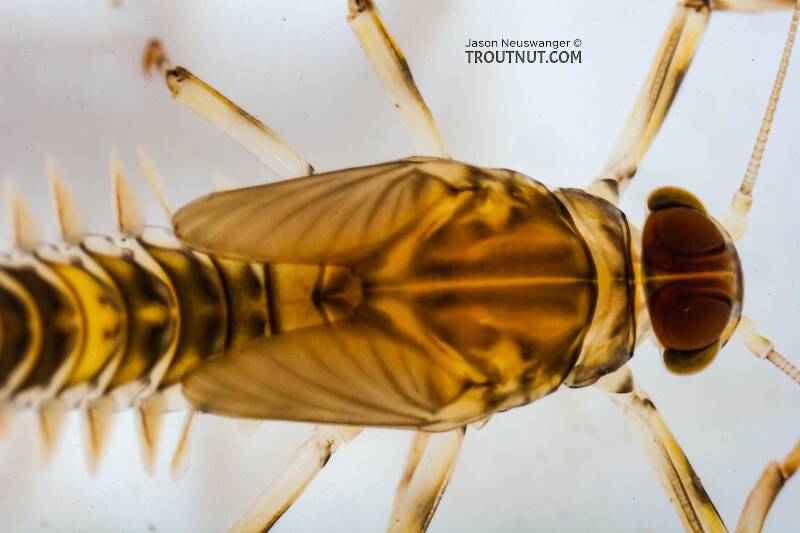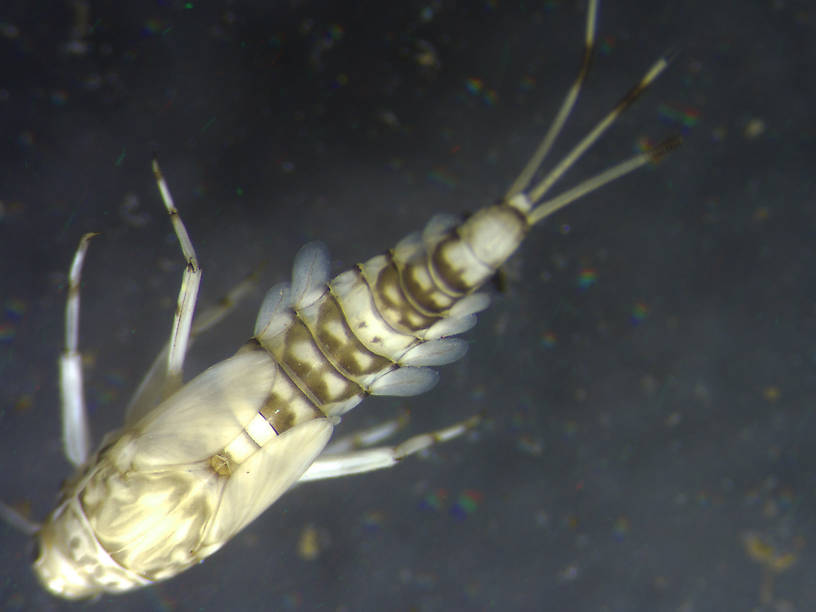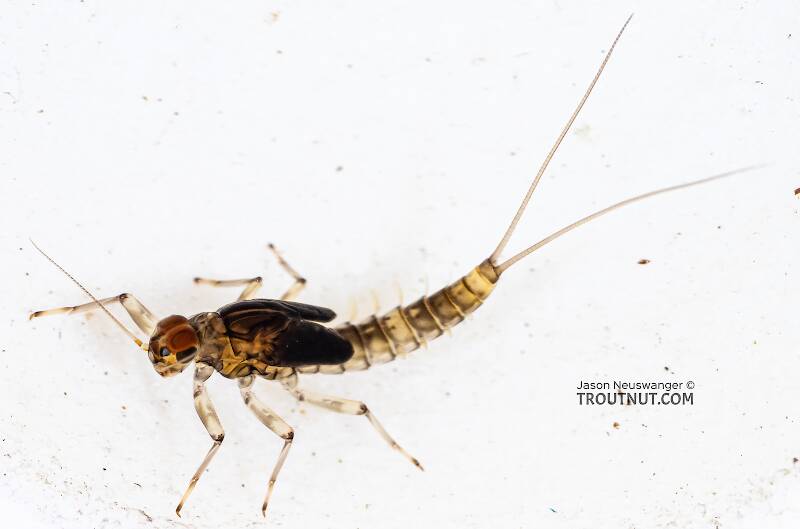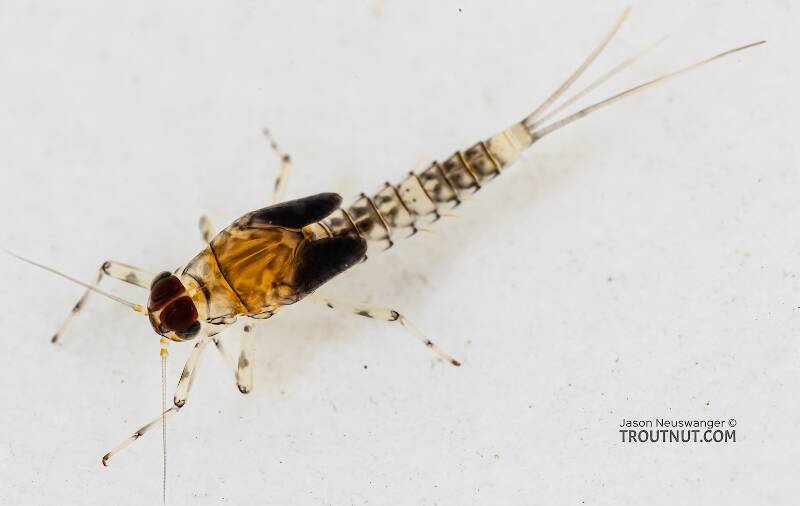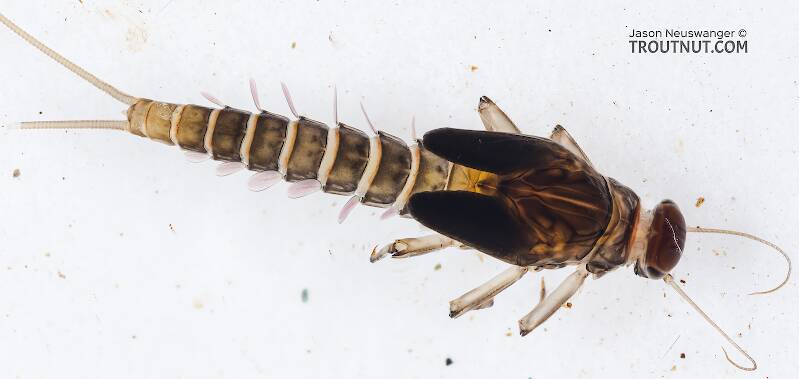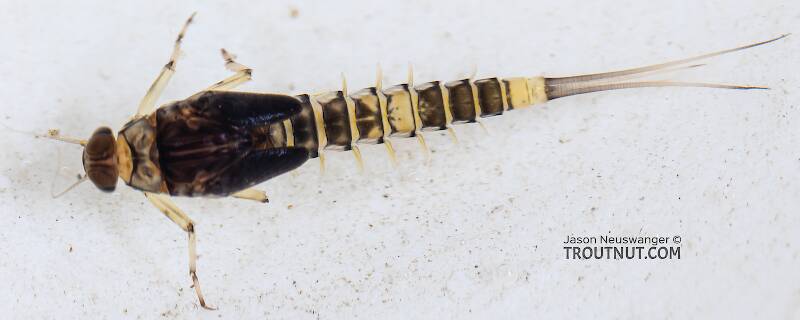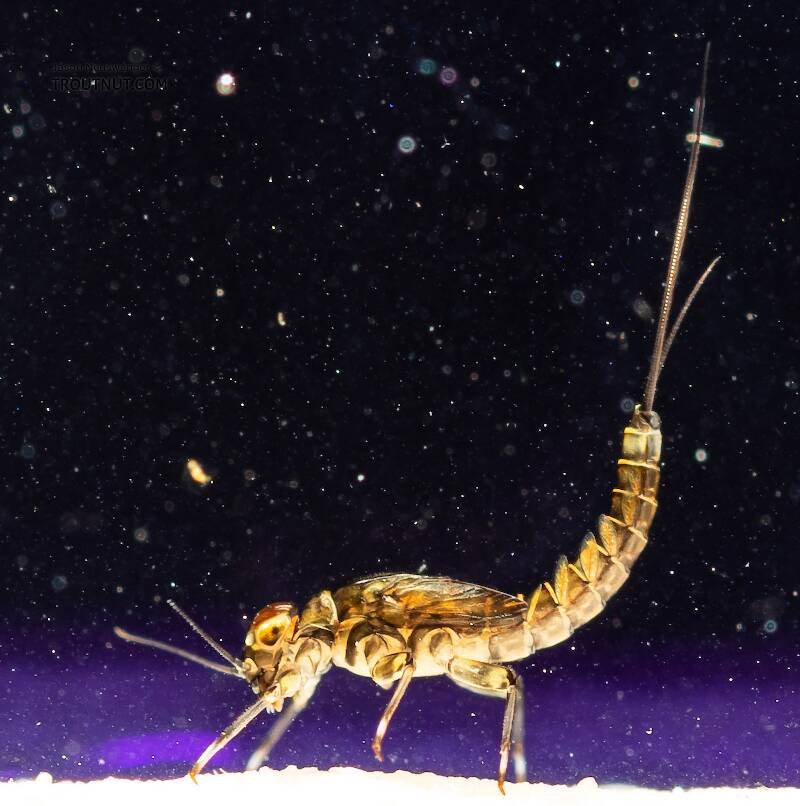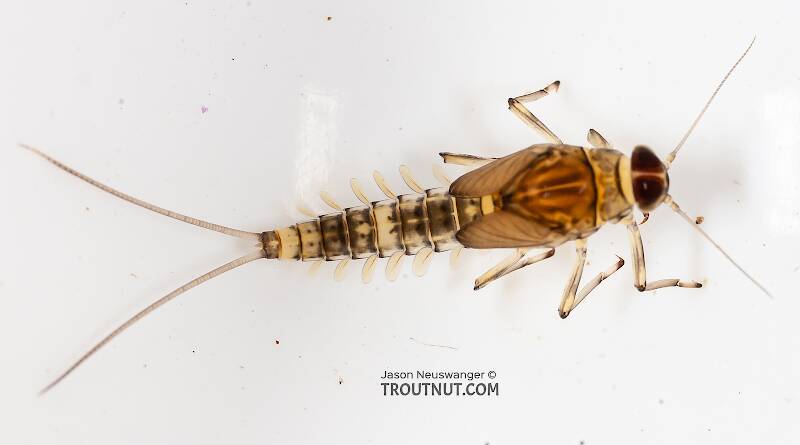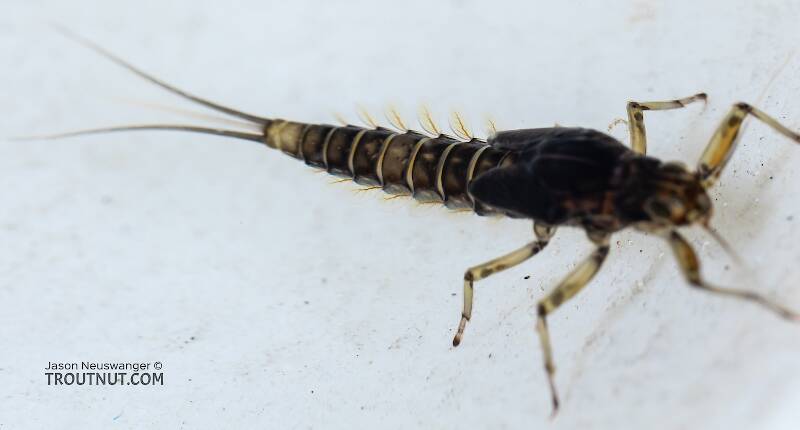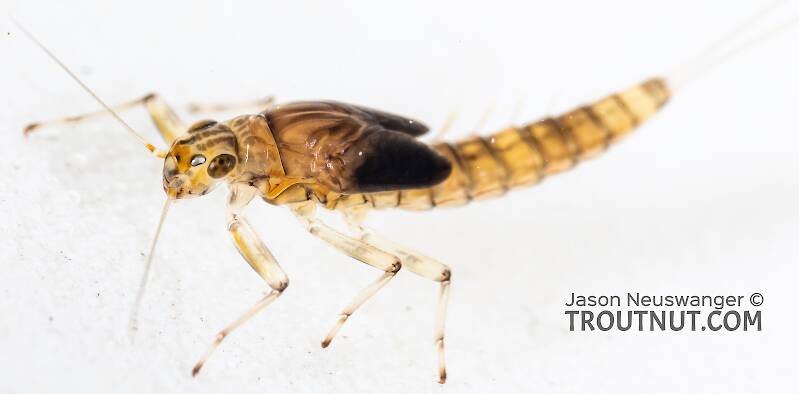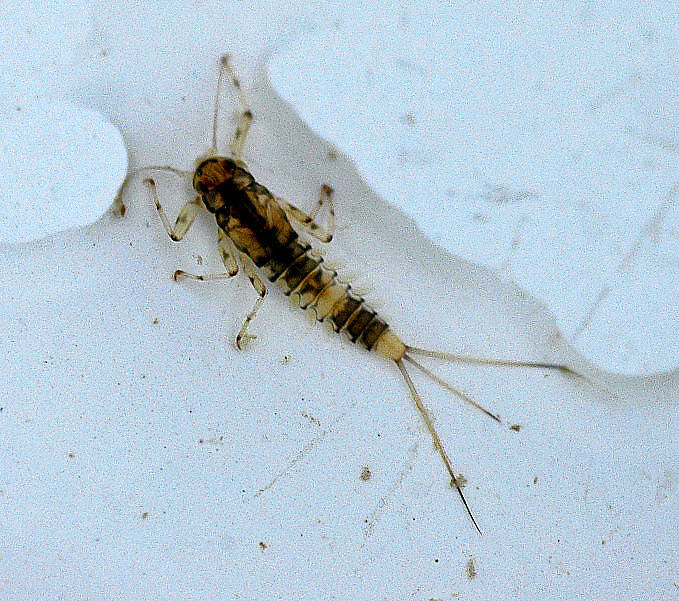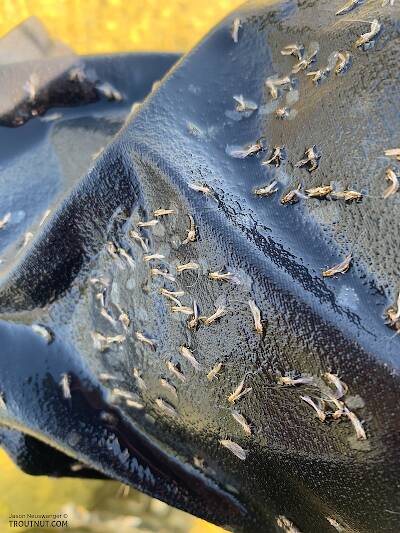
Hex Mayflies
Hexagenia limbata
The famous nocturnal Hex hatch of the Midwest (and a few other lucky locations) stirs to the surface mythically large brown trout that only touch streamers for the rest of the year.
Featured on the forum
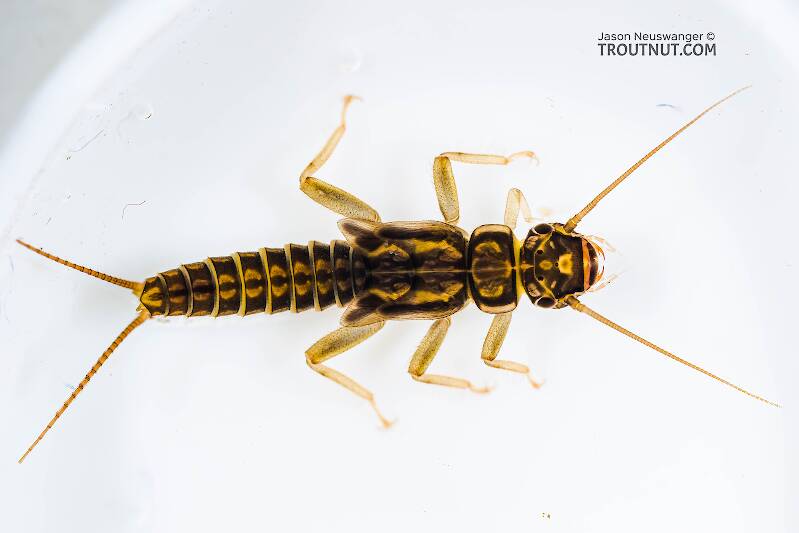

Troutnut is a project started in 2003 by salmonid ecologist Jason "Troutnut" Neuswanger to help anglers and
fly tyers unabashedly embrace the entomological side of the sport. Learn more about Troutnut or
support the project for an enhanced experience here.
Mayfly Genus Baetis (Blue-Winged Olives)

The genus Baetis and its species are probably the most misidentified mayflies in angling. Many who see mayflies too small to imitate with a size 16 Adams call them Baetis, especially if they're olive in coloration. In reality, Baetis (though the most prominent) is only one of several very similar and abundant genera in the family Baetidae. It seems species in the family are perpetually being reclassified, and identifying any of them, even to genus level is difficult. The angler who wants to describe what is seen streamside usually has only four choices:
1. Call them "Blue-Winged Olives" as most do. the problem is this name has lost all meaning due to being applied to dozens of species across several families (many of which have neither blue wings nor olive bodies). Besides, the name was originally coined for a species of British ephemerellid, the family where this common name should properly reside.
2. Call them "baetids", the Latin name for referring to members of the Baetidae family as a group. While technically accurate scientifically, it doesn't tell the listener or reader much about their appearance.
3. Call them outmoded scientific names - Even calling them by the updated name is usually risky for most species in the field. Adding to the difficulty by using names from outdated nomenclatures? Talk about confusion...
4. Call them "little (whatever color they are) quills." Perhaps this is the best choice as at least it's more accurately descriptive.
The fact is many are so similar that even alot of the specimens in the hatch pages can't be keyed below the family level with absolute certainty; at least from what's observable in the photos alone. They often require observation with a microscope and extensive knowledge of the subtle differences for accurate determinations. So - the next time a fishing buddy identifies a little olive mayfly from a distance using an obsolete name like Baetis vagans, just smile and nod...
For anglers raised on Schwiebert, Swisher, etc., it is often difficult to locate many important species in the newer literature. When working with older taxonomies and/or angling texts, the following hatch page links may prove helpful:
Baetis devinctus = Diphetor hageni (can be an important eastern species)
Baetis hiemalis = Baetis brunneicolor (important Midwest species with a national distribution)
Baetis insignificans = Acentrella insignificans (can be important in some western locales)
Baetis parvus = Diphetor hageni (very important western species)
Baetis propinquus = Labiobaetis propinquus (important in the West with a national distribution)
Baetis pygmaeus = Acerpenna pygmaea (can be important with distribution across all regions)
Baetis vagans = Baetis tricaudatus (most abundant and important species nationwide)
The relatively new genus Fallceon has two species of interest that are made up of several previous Baetis species. They are distributed nationally and may prove significant as more is learned about the angling opportunities they present, especially in the the South and Southwest.
Where & when
Some Baetis species are often the first major hatches in the spring and the last in the fall, and on especially stable spring creeks they may emerge throughout the winter. The genus is common nationwide.See each species page for more on their distribution and timing.
In 261 records from GBIF, adults of this genus have mostly been collected during July (29%), June (28%), August (14%), May (9%), and April (8%).
In 509 records from GBIF, this genus has been collected at elevations ranging from -30 to 11037 ft, with an average (median) of 3182 ft.
Genus Range
Hatching behavior
Baetis nymphs are normally outstanding swimmers, but they are reported to lose this ability when they emerge. They get to the surface by dead-drifting, buoyed by gas bubbles, or by crawling to the surface on some object and letting go to drift along in the film (rather than crawling out). They have trouble breaking through the surface film, escaping their shucks, and drying their wings to take flight, which means that almost any type of surface fly has its uses. Anglers may need to use deep nymphs, floating nymphs, emergers, cripples, or dun patterns during this emergence. Common wisdom says floating nymph and emerger patterns are the most useful.
Dismal weather invites the best hatches of Baetis mayflies; look for them on overcast, rainy days, as long as the water temperature is above 40°F.
Spinner behavior
Timing the return of these mayflies as spinners after they hatch is difficult; some may come back within a few hours, while others take a few days.Baetis females are among the only mayflies to lay their eggs underwater. The females land near the water after mating and crawl down to lay rows of eggs on the downstream side of rocks, sticks, and other objects. They may slip loose during the process or let go after they finish, and wet fly imitations are effective during this time. Ernest Schwiebert gives more detail in Matching the Hatch:
In moving through the surface film she folds her wings about her abdomen and uses the downstream side of the object she has selected. The passing through the surface film is the critical phase of her mating. Once she is under the surface, she inspects the rock or log carefully with her abdomen. Finally she lays her eggs with a circular sweeping motion, which leaves a little row of eggs each time. When her supply of eggs is exhausted she climbs back out of the water or is swept away in the underwater currents.
Nymph biology
Baetis nymphs are found in almost every trout stream, but they produce more broods and thicker hatches in cold, unpolluted, alkaline waters. They inhabit almost every microhabitat in the stream except for silt beds, but gravel and vegetation are especially suitable.Baetis Fly Fishing Tips
Because Baetis mayflies are so often called Blue-Winged Olives, some anglers try to imitate them with flies with blue wings and olive bodies. This is one of the follies of common names. Their wings are various shades of gray, maybe with a slight blue tint, and their bodies are various shades of olive or brown. When you meet a hatch, try to catch one of the live mayflies rather than assuming you know its color.Specimens of the Mayfly Genus Baetis
3 Male Duns
8 Female Duns
3 Male Spinners
4 Female Spinners
18 Nymphs
1 Streamside Picture of Baetis Mayflies:
Discussions of Baetis
Big Green River, Wisconsin, late September
1 replies
Posted by Admiralb on Sep 28, 2013 in the species Baetis brunneicolor
Last reply on Sep 30, 2013 by Entoman
I hosted two visiting delegates to the T.U. National Convention in Madison, WI. on September 25, 2013, taking them to the Big Green River in Grant County near Fennimore. There was a high overcast in the morning, and these mayflies [which I merely called "BWO's" and imitated with #16 parachute dries - thin olive bodies, gray wing posts and dun parachute hackle] - were active. Both of my guests raised browns fishing a gray nymph behind a #16 parachute dry BWO. As long as my flies catch fish, I don't need to be a detailed entomologist. Nevertheless, I do sincerely appreciate the detailed scientific info, because it helps me focus my flytying and fly selection. Thank you.
Baetis flavistriga computatii
7 replies
Posted by CaseyP on Jan 22, 2007 in the species Baetis flavistriga
Last reply on Jan 19, 2009 by Taxon
pleased to report the emergence of a new baetis flavistriga which i have christened computatii
forum visitors using the Firefox browser who put troutnut.com on their bookmarks toolbar have undoubtedly noticed a tiny dark mayfly icon in a blue box next the bookmark.
well, it's breeding. came back this evening from a week out of town to discover that the little troutnut computatii had a pal over next the hotmail.com bookmark where formerly there was only a generic white icon. am waiting for it to show up next the other two sites that have only generic icons.
now our resident boffins will help me with the Latin ending on the new name, (i tried to use the genitive plural) and then we'll ask Jason how he got these virtual flies to multiply.
Casey
flavistriga broods
Posted by Konchu on Jan 17, 2009 in the species Baetis flavistriga
Last reply on Jan 17, 2009 by Konchu
Anyone have observations that they are willing to share of different flavistriga broods?
Jason says that B. flavistriga is a "combination of widely varying types in different places, it's hard to piece the information together into reliable hatch dates for the different broods in any given location." This is stated very well.
As part of my bug work, I'm trying to tease apart some of these "varying types" to see what, if anything, they might represent. Tapping into the experience base here might help.
Jason says that B. flavistriga is a "combination of widely varying types in different places, it's hard to piece the information together into reliable hatch dates for the different broods in any given location." This is stated very well.
As part of my bug work, I'm trying to tease apart some of these "varying types" to see what, if anything, they might represent. Tapping into the experience base here might help.
Start a Discussion of Baetis
References
- Caucci, Al and Nastasi, Bob. 2004. Hatches II. The Lyons Press.
- Fauceglia, Ted. 2005. Mayflies . Stackpole Books.
- Leonard, Justin W. and Fannie A. Leonard. 1962. Mayflies of Michigan Trout Streams. Cranbrook Institute of Science.
- Schwiebert, Ernest G. 1955. Matching the Hatch. MacMillan Publishing Company.
- Swisher, Doug and Carl Richards. 2000. Selective Trout. The Lyons Press.
Mayfly Genus Baetis (Blue-Winged Olives)
Taxonomy
Species in Baetis
Baetis adonis
0
0
Baetis bicaudatusPale Olive Duns
6
48
Baetis brunneicolorBlue-Winged Rusty Duns
0
0
Baetis flavistrigaDark Blue-Winged Olives
3
14
Baetis intercalarisSmall Eastern Blue-Winged Olives
0
0
Baetis magnusIron Blue Quills
0
0
Baetis phoebus
0
0
Baetis piscatoris
0
0
Baetis pluto
0
0
Baetis posticatus
0
0
Baetis rusticans
0
0
Baetis tricaudatusBlue-Winged Olives
13
117
Species in Baetis: Baetis adonis, Baetis bicaudatus, Baetis brunneicolor, Baetis flavistriga, Baetis intercalaris, Baetis magnus, Baetis phoebus, Baetis piscatoris, Baetis pluto, Baetis posticatus, Baetis rusticans, Baetis tricaudatus
11 species (Baetis alius, Baetis bundyae, Baetis caurinus, Baetis diablus, Baetis foemina, Baetis hudsonicus, Baetis moqui, Baetis notos, Baetis palisadi, Baetis parallelus, and Baetis persecutor) aren't included.

